
Syllabus for General Astronomy at Queens College
- Subject:
- Astronomy
- Physical Science
- Material Type:
- Syllabus
- Provider:
- CUNY Academic Works
- Provider Set:
- Queens College
- Author:
- Goldberg, David
- Date Added:
- 01/01/2023

Syllabus for General Astronomy at Queens College

This two week assignment asks students to interpret and analyze the 1974 Arecibo Message sent by Drake and Sagan. Week 1 introduces the concepts behind the construction of the message and engages with a critical analysis of the architecture and the contents of the message. Week 2 asks students to develop software in a Jupyter Notebook (available for free from the Anaconda Python Distribution) to interpret messages that were similar to those produced by Drake and Sagan.
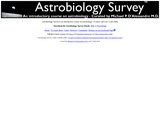
Astrobiology Survey is an introductory course on astrobiology. It takes a multi-disciplinary approach that unites the sciences and arts to study the three questions of "How does life begin and evolve?", "Does life exist elsewhere in the universe?" and "What is the future of life on Earth and beyond?"

" This course covers the fundamentals of astrodynamics, focusing on the two-body orbital initial-value and boundary-value problems with applications to space vehicle navigation and guidance for lunar and planetary missions, including both powered flight and midcourse maneuvers. Other topics include celestial mechanics, Kepler's problem, Lambert's problem, orbit determination, multi-body methods, mission planning, and recursive algorithms for space navigation. Selected applications from the Apollo, Space Shuttle, and Mars exploration programs are also discussed."

Astronomy is designed to meet the scope and sequence requirements of one- or two-semester introductory astronomy courses. The book begins with relevant scientific fundamentals and progresses through an exploration of the solar system, stars, galaxies, and cosmology. The Astronomy textbook builds student understanding through the use of relevant analogies, clear and non-technical explanations, and rich illustrations. Mathematics is included in a flexible manner to meet the needs of individual instructors.
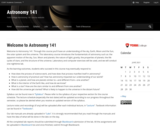
Welcome to Astronomy 141. Through this course you’ll have an understanding of the sky, Earth, Moon and the Sun, the solar system and the universe. This laboratory course introduces the fundamentals of astronomy such as: the apparent motion of the sky, Sun, Moon and planets; the nature of light; gravity; the properties of planets; the life cycles of stars; and the structure of the universe. Laboratory and computer exercises will be used, and we will conduct one nighttime lab.
As the learning outcomes, students who succeed in this course may eventually respond to:
How does the process of science work, and how does that process manifest itself in astronomy?
How is astronomy of practical use? How has astronomy impacted our understanding of our world?
What is a planet, and how are planets similar to—and different from—one another?
What is the interior of the Earth like, and how do we know?
What is a star? How are the stars similar to and different from one another?
How did the universe get started? What is likely to happen to the universe in the distant future?
[This project was created as part of the Open Pedagogy Fellowship at the Mina Rees Library, The Graduate Center].
Read more about the course design here: https://gclibrary.commons.gc.cuny.edu/2020/10/19/inclusive-education-and-research-for-astronomy/

Intended for all audiences, this textbook is an introduction to the nature of the universe. Use it to research or review our solar system, stars, galaxies, and the history of the universe. Each chapter has a set of corresponding homework questions.
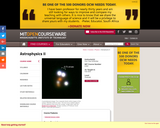
Galactic dynamics: potential theory, orbits, collisionless Boltzmann equation, etc. Galaxy interactions. Groups and clusters; dark matter. Intergalactic medium; x-ray clusters. Active galactic nuclei: unified models, black hole accretion, radio and optical jets, etc. Homogeneity and isotropy, redshift, galaxy distance ladder. Newtonian cosmology. Roberston-Walker models and cosmography. Early universe, primordial nucleosynthesis, recombination. Cosmic microwave background radiation. Large-scale structure, galaxy formation.

Size and time scales. Historical astronomy. Astronomical instrumentation. Stars: spectra and classification. Stellar structure equations and survey of stellar evolution. Stellar oscillations. Degenerate and collapsed stars; radio pulsars. Interacting binary systems; accretion disks, x-ray sources. Gravitational lenses; dark matter. Interstellar medium: HII regions, supernova remnants, molecular clouds, dust; radiative transfer; Jeans' mass; star formation. High-energy astrophysics: Compton scattering, bremsstrahlung, synchrotron radiation, cosmic rays. Galactic stellar distributions and populations; Oort constants; Oort limit; and globular clusters.
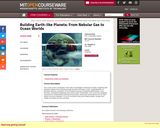
" This course covers examination of the state of knowledge of planetary formation, beginning with planetary nebulas and continuing through accretion (from gas, to dust, to planetesimals, to planetary embryos, to planets). It also includes processes of planetary differentiation, crust formation, atmospheric degassing, and surface water condensation. This course has integrated discussions of compositional and physical processes, based upon observations from our solar system and from exoplanets. Focus on terrestrial (rocky and metallic) planets, though more volatile-rich bodies are also examined."

A collection of science simulations that illustrate an abstract concept or idea from basic science, without cluttering the screen with unnecessary elements.
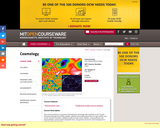
Thermal backgrounds in space. Cosmological principle and its consequences: Newtonian cosmology and types of "universes"; survey of relativistic cosmology; horizons. Overview of evolution in cosmology; radiation and element synthesis; physical models of the "early stages." Formation of large-scale structure to variability of physical laws. First and last states. Some knowledge of relativity expected. 8.962 recommended though not required. This course provides an overview of astrophysical cosmology with emphasis on the Cosmic Microwave Background (CMB) radiation, galaxies and related phenomena at high redshift, and cosmic structure formation. Additional topics include cosmic inflation, nucleosynthesis and baryosynthesis, quasar (QSO) absorption lines, and gamma-ray bursts. Some background in general relativity is assumed.

The Early Universe provides an introduction to modern cosmology. The first part of the course deals with the classical cosmology, and later part with modern particle physics and its recent impact on cosmology.
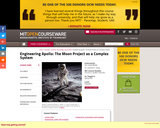
This course is a detailed technical and historical exploration of the Apollo project to "fly humans to the moon and return them safely to earth" as an example of a complex engineering system. Emphasis is on how the systems worked, the technical and social processes that produced them, mission operations, and historical significance. Guest lectures are featured by MIT-affiliated engineers who contributed to and participated in the Apollo missions. Students work in teams on a final project analyzing an aspect of the historical project to articulate and synthesize ideas in engineering systems.

The year is 2050 and your once-idyllic beachfront vacation home is now flooded up to the second story. The crab your family has enjoyed every Christmas for as long as you can remember has now become an endangered species. The oceans have changed. In Earth 540, Oceanography for Educators, we explore the mechanisms that lead to sea level rise and ocean acidification. We strive to understand how natural processes such as ocean currents, the gulf-stream, tides, plate tectonics, and the Coriolis Effect, affect our oceans and ocean basins. We then predict how man-made issues such as climate change and overfishing will affect our beloved waters and our livelihoods. Want to see into the future? Then this course is for you!
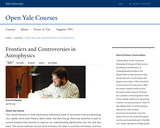
This course focuses on three particularly interesting areas of astronomy that are advancing very rapidly: Extra-Solar Planets, Black Holes, and Dark Energy. Particular attention is paid to current projects that promise to improve our understanding significantly over the next few years. The course explores not just what is known, but what is currently not known, and how astronomers are going about trying to find out.

The spring 2017 syllabus for the General Astronomy Course (AST 110), developed as part of the textbook free courseware initiative at Borough of Manhattan Community College.

This course provides an introduction to the universe beyond the Earth. We begin with a study of the night sky and the history of the science of astronomy. We then explore the various objects seen in the cosmos including the solar system, stars, galaxies, and the evolution of the universe itself. As an online course, it is equivalent to 6 lecture hours, and satisfies science requirements for the AA and AS degree. It is designed to be thorough enough to prepare you for more advanced work, while presenting the concepts to non-majors in a way that is meaningful and not overwhelming. We will consider the course a success if you have learned how to think about the universe critically in an organized, logical way, and to have enhanced your appreciation of the sky around us.

" The fundamental concepts, and approaches of aerospace engineering, are highlighted through lectures on aeronautics, astronautics, and design. Active learning aerospace modules make use of information technology. Student teams are immersed in a hands-on, lighter-than-air (LTA) vehicle design project, where they design, build, and fly radio-controlled LTA vehicles. The connections between theory and practice are realized in the design exercises. Required design reviews precede the LTA race competition. The performance, weight, and principal characteristics of the LTA vehicles are estimated and illustrated using physics, mathematics, and chemistry known to freshmen, the emphasis being on the application of this knowledge to aerospace engineering and design rather than on exposure to new science and mathematics."

This course includes Quantitative introduction to physics of the solar system, stars, interstellar medium, the Galaxy, and Universe, as determined from a variety of astronomical observations and models. Topics: planets, planet formation; stars, the Sun, "normal" stars, star formation; stellar evolution, supernovae, compact objects (white dwarfs, neutron stars, and black holes), plusars, binary X-ray sources; star clusters, globular and open clusters; interstellar medium, gas, dust, magnetic fields, cosmic rays; distance ladder; galaxies, normal and active galaxies, jets; gravitational lensing; large scaling structure; Newtonian cosmology, dynamical expansion and thermal history of the Universe; cosmic microwave background radiation; big-bang nucleosynthesis. No prior knowledge of astronomy necessary. Not usable as a restricted elective by physics majors.